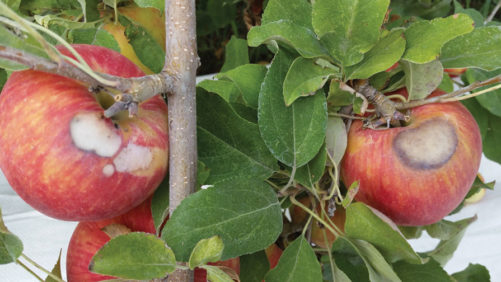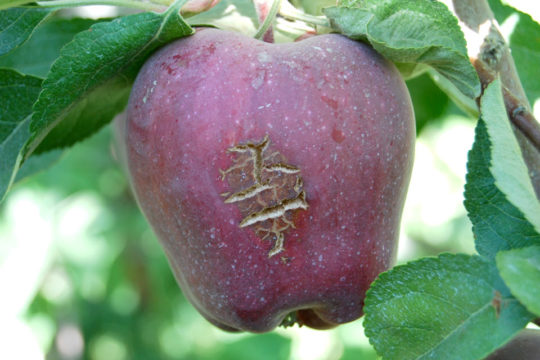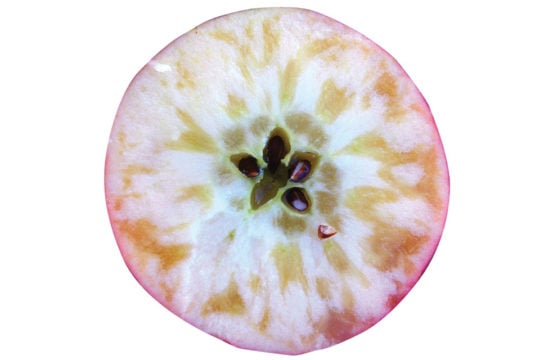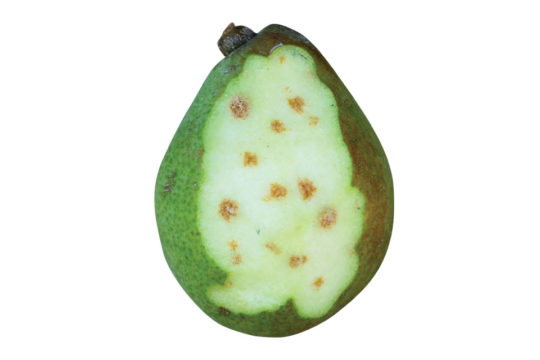Industry News, Agriculture & Feed, Adjuvants
Washington Growers Seeing the Effects of Sunburn

Industry News, Agriculture & Feed, Adjuvants

Image: Growing Produce
High temperatures and drought made for a challenging growing season for tree fruit growers in Washington. Prolonged exposure to intense heat and light, as well as low humidity and drought, have resulted in apples showing signs of sunburn- and heat-related disorders.

Sunburn necrosis on ‘Honeycrisp.’ (Photo: Byron Phillips) © Growing Produce
Tory Schmidt, project manager for the Washington Tree Fruit Research Commission; Rob Blakey of Washington State University (WSU) Extension; and Byron Phillips, National Crop Specialist for Valent; talk about what types of disorders they saw this season.
Earlier in the season, in late June and early July, growers saw typical disorders associated with sunburn, such as sunburn browning, sunburn necrosis, and photo-oxidative sunburn, says Phillips. However, later, from about mid-July to mid-September, growers experienced heavy smoke from forest fires in the West, which reduced light and temperatures, somewhat reducing sunburn.
“The smoke largely filtered the sunlight and appeared to have reduced surface sunburn, but ultimately proved to be deceptive as the incidence and severity of sub-surface heat-related disorders increased dramatically,” says Phillips. “We’ve seen more heat-induced or high-temperature water core than ever before, along with some internal browning just under the skin as a result of the apple literally being ‘cooked.’”

Heat cracking on a ‘Red Delicious’ apple. (Photo: Byron Phillips) © Growing Produce
Schmidt, says he believes there may be more sunburn browning than usual this year.
“It’s more subtle. It can sometimes get colored over,” Schmidt says, adding that it’s probably more prevalent because there were many days this summer that were just hot enough to cause sunburn browning, but the temperatures were not necessarily extreme enough to cause the black lesions seen with sunburn necrosis.
At harvest, Phillips says he has seen increased fruit cracking and a wide variation of fruit maturity that he says is the direct result of stress from prolonged heat, low humidity, and drought.

Watercore caused by high temperatures. (Photo: Byron Phillips) © Growing Produce
Blakey, a Tree Fruit Extension Specialist, reports seeing some sunburn-related disorders, heat stress, drought spot, lenticel issues, and defects related to over-mature fruit in the early and mid-season cultivars. These stress-related disorders, along with small fruit size, increase the risk of internal browning during storage
Phillips and Schmidt agree it may be too early to get a full picture of the effects of sunburn, and some disorders might not show up until the fruit is in storage. Many storage-related disorders may not be evident until February or March, Schmidt says.
“I anticipate seeing more delayed sunburn, stain, and internal browning developing in storage this year as a result of the summer weather,” Phillips agrees.
Phillips and Schmidt both report that growers have observed cork spot on ‘d’Anjou’ pears this year. Cork spot is a calcium-related disorder, similar to bitter pit in apples. However, in the past several years, Phillips has observed the disorder to be associated with sunburn.

Cork spot in ‘Anjou’ pear. (Photo: Byron Phillips) © Growing Produce
“I think this is probably because cork spot symptoms start to show during periods of heat and water stress,” he says.
“As a pear grower, this has been a very difficult year for cork,” says Schmidt, adding that it is the result of having prolonged periods of high temperatures.
Because of this, Schmidt says he “wouldn’t be at all surprised if this is a very bad year for bitter pit.”
“It’s likely that our cork spot management strategies need to include some sort of sunburn/heat protection in addition to calcium and nitrogen management, and I’ve started looking at that this season,” adds Phillips.